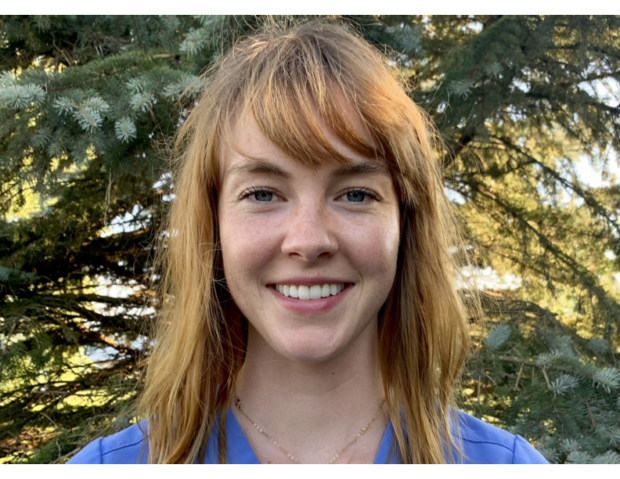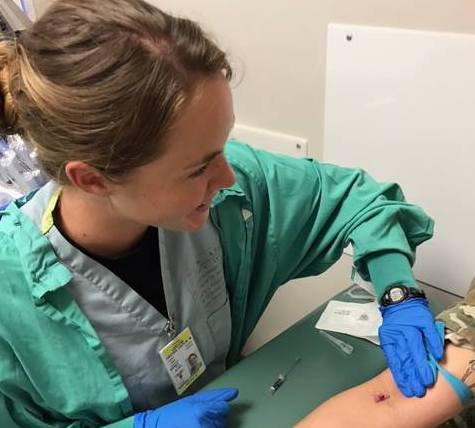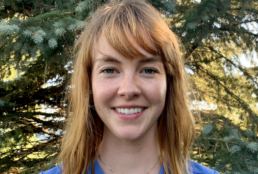A family of nurses with mother and daughter in the same hospital
As published in Columbia Journalism
A family of nurses with mother and daughter in the same hospital
Gretchen Tarrant

The pandemic made them realize what they cherish the most.
With her warm yet no-nonsense demeanor, Caitlin Hester almost seems like a born nurse, the kind you might expect to see on a season of Grey’s Anatomy; although her mother Darlene Hester, who pioneered as the nurse in the family, never anticipated seeing her daughter in scrubs.
Darlene Hester, 53, has worked as an intensive care nurse since 1991, and at the University of Vermont Medical Center in Burlington, Vt. since 1997, before her daughter was born. She later covered weekend shifts as she raised the younger Hester and her three siblings.
It is not uncommon for daughters to follow mothers into nursing. But what is unusual about the Hesters is that they work in the same hospital, in fact, in the same intensive care unit. In Darleen’s 30 years as a nurse, she has never met another mother-daughter combination working in tandem.
“My mom would always come home with interesting stories about her day,” Caitlin Hester, 25, recalled on her turn to nursing, “and I was interested in science, so it seemed like a natural fit.”
But that’s not quite how her mother remembers it.
“Caitlin came to shadow me once, and I was pretty busy, so I didn’t have a lot of time to talk,” Darlene Hester said,”but she didn’t ask me many questions, so I figured maybe it wasn’t for her.”
Call it fate, call it genetics, call it a high school student desperate for a summer job. Whatever the case, Caitlin Hester ultimately spent a summer as a nursing assistant at Starr Farm Nursing Center in Burlington, Vt. There, in between turning, cleaning, and administering medication, she met a patient that would change her life.
“He was an elderly man, dementia, high fall risk,” she said, rattling off his ailments like she was reading his chart. “But one day I started looking at the pictures above his bed. He was a World War II pilot. He had a beautiful wife, and kids. I could almost see his life unfolding in the pictures — in each one he got older. His kids grew up. I saw him riding bikes, doing things he liked. ”
It was a moment that Caitlin Hester continues to come back to on the hard days.
“He’s had a full life and done more things than I have. I think about that when I find myself getting numb,” she said.
But for those who know either Hester, “numb” is not the adjective of choice.
“Both Caitlin and Darlene have tremendous compassion for their patients. Both are great advocates,” Pat Delaney, an 18-year veteran at the University of Vermont Medical Center, said.
Delaney, 48, has worked with Darlene Hester for most of his career and was responsible for training Caitlin when she joined their ranks some years later.
After that summer at Starr Farm, Caitlin Hester went on to pursue a nursing degree at the University of Vermont while training as a cadet with the Reserve Officers Training Corps (ROTC). She graduated in May of 2018 with honors in both, landing a job in the critical care unit at Medstar Georgetown University Hospital in Washington, D.C.
“She’s definitely the most disciplined of the four of us,” said Joey Hester, Caitlin’s younger brother.
That discipline proved invaluable for her working on the surgical cardio-vascular floor at Medstar where there wasn’t room for error. One shift brought her to tears: it was an all-too-common scenario, she would learn; nurses juggling too many patients, families frustrated and angry, Hester and her colleagues caught in the middle.
“There’s not much emotional support for nurses sometimes,” she said. “Patients die. Then you’re on the list for a new patient.”
Caitlin Hester is now completing her certification as a registered nurse anesthetist at California State Fullerton/Kaiser Permanente.
 Of the eight nurses she started with, only one is left on the floor. The other seven have moved on to more relaxed roles, such as working in health care administration or going back to school. Caitlin Hester herself spent a year at Medstar before transferring back to the University of Vermont Medical Center in June 2019, where she wound up working on the same 25-bed surgical intensive care unit her mother has worked for 30 years.
Of the eight nurses she started with, only one is left on the floor. The other seven have moved on to more relaxed roles, such as working in health care administration or going back to school. Caitlin Hester herself spent a year at Medstar before transferring back to the University of Vermont Medical Center in June 2019, where she wound up working on the same 25-bed surgical intensive care unit her mother has worked for 30 years.
The transition wasn’t difficult. Despite Vermont’s lower pay and lagging staffing policies, it was a place that felt close to home with her mother around. But six months into her new job, COVID-19 reached US soil; a development that would bring her to tears more than once as she witnessed a multitude of lonely deaths.
By March 7, 2020, the state of Vermont registered its first presumptive COVID case, and her hospital’s management immediately separated critical care into COVID and non-COVID units to stave off potential spread of infections and deal with an anticipated surge in patients. Although the Hesters’ floor didn’t deal directly with COVID, their unit was far from untouched.
Shortly after the first confirmed case, all non-emergency surgeries were paused. As the state prepared for the onslaught of an unprecedented illness, the surgical ICU nurses (including both mother and daughter) were sent home.
Many of the nurses didn’t mind the time off at first, but as weeks stretched into months the lack of paychecks became worrisome.
And it wasn’t just the nurses that needed their paychecks; the hospital was going broke without its usual surgery premiums. Out of necessity for both the patients and the hospital, the surgical ICU resumed operations, but things were far from business as usual.
“During COVID a lot of us started to have really distressing death experiences,” Caitlin Hester said. “We weren’t even a covid floor, but they didn’t allow visitors. The worst deaths I’ve been a part of were ones where I was the only one in the room.”
Unfortunately, with COVID, suffering a lonely death was common. Throughout 2020, University of Vermont Medical vacillated between zero-tolerance visitation policies and thresholds of one or two people in cases where death was imminent. It’s a policy that doesn’t always sit well with the nurses on the floor.
Darlene Hester recalled a time when she admitted a father of three who suffered a severe head injury. He was dying, and at the time the hospital’s policy was to only allow two people to be with a person during the final moments. She asked herself, “which three kids should leave when their dad’s dying?”
The experience crystallized her conviction in advocating for her patients.
“When someone is scared and vulnerable and sick, it can be very frustrating for the staff, even when we’re aware this is bigger and beyond and just the here and now,” Delaney said.“We try as best we can, but when someone has a breathing tube in they can’t tell us; ‘I like NASCAR,’ or ‘Oh I like to knit.’”
Darlene Hester has done her best to advocate for a change in visitation policies, even writing letters to Governor Scott of Vermont — to no avail.
“This is a lifetime of agony you are providing for these families to live with the memory of never seeing their loved one,” Darlene Hester said.
Not only is the emotional toll heavy on families in end-of-life situations, but as both mother and daughter have experienced, the visitation policies also affect patient care decisions. Families who aren’t able to visit loved ones in the hospital often drag out the dying process in ways that may lead to a more painful death.
“When families can’t be in the hospital and they say: ‘do everything,’ often they can’t comprehend what ‘everything’ means without a visual,” Darlene Hester explained.
 Caitlin Hester offers an additional perspective. “Death can be a beautiful, loving thing. That’s why it’s really important to do it right.”
Caitlin Hester offers an additional perspective. “Death can be a beautiful, loving thing. That’s why it’s really important to do it right.”
Rather than burning out, Caitlin Hester has doubled down on nursing. She recently moved across the country to become certified as a registered nurse anesthetist (CRNA) at California State Fullerton/Kaiser Permanente. She also adopted a dog she named Doug, which, according to her family, really brings out the caretaker in her.
Darlene Hester has picked up more shifts at the hospital, working multiple 12-hour days a week now that her youngest child, Amy, has her driver’s license.
Her husband says she gets excited working back-to-back days at the hospital, since she knows she’ll be able to care for the same patients.
And, as Darleen Hester points out, there are always signs of hope that make it all worth it.
She recalls a sixteen-year-old girl a few years back who came in with what seemed like a terminal head injury. She had crashed while skiing on vacation with her family. The parents were, in her words, “a mess.” Somehow, their daughter not only survived, but regained her ability to walk, play music, and is now attending college. She returns to the unit every year for her necessary scans.
Darlene Hester smiled, “She’s our little miracle.”

